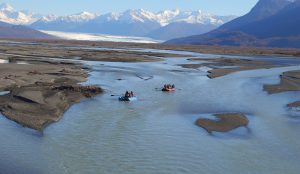In April, the State of Alaska filed a lawsuit against the federal Bureau of Land Management, asserting that Alaska owns the land under about twelve river miles at the head of the Knik River northeast of Anchorage. But, according to Alaska Department of Natural Resources spokesperson Brent Goodrum, the BLM took an important step this week towards declaring the Upper Knik River the property of Alaska.

“BLM announced that they revisited an old navigability determination on the Knik River, and in doing so, they have essentially reversed their decision on finding that the river is navigable from Friday Creek all the way to the Knik Glacier,” Goodrum said.
The laws surrounding river ownership in Alaska come down to one central question: was the body of water navigable in 1959, when Alaska became a State?
It’s not as simple a question as it might seem — the BLM and the State have not approached this question in the same way, often resulting in different conclusions and litigation. The BLM has long focused its navigability determinations on whether watercraft actually used the river in 1959. But the State has been advocating for a broader approach.
“There is a criteria that talks about whether a water body was susceptible to use for trade, travel, and commerce,” Goodrum said.
According to the State of Alaska, if a river could have been navigated at statehood, then it should belong to Alaska.
Just last month, prompted by new evidence provided by the State, BLM’s own field study revealed the Upper Knik is deep enough to have been used by 24-foot propeller-driven boats, which were common at the time of statehood. As a result, the BLM reversed its previous decisions and declared this week that the Upper Knik river is navigable.
This determination should help reduce litigation and clear up title to the Upper Knik. It also may signal increased cooperation between the BLM and the State of Alaska on other rivers and lakes. And the effects will percolate to many people across the state.
“I think all Alaskans are interested in access to our lands and waters, and the further you get away from road access, as you get into more interior parts of Alaska, rivers are vital access means to our lands and resources,” Goodrum said.
Goodrum said the State of Alaska continues to look for more ways to work with the federal government to create a transparent approach to determine and clarify ownership and management of rivers and lakes in Alaska.
Independent producer Vikram Patel works full-time for the Municipality of Anchorage Parks and Recreation Department. In his free time, he volunteers for local storytelling program Arctic Entries and produces "New Arrivals," a profile series on KSKA about newcomers to Anchorage.




